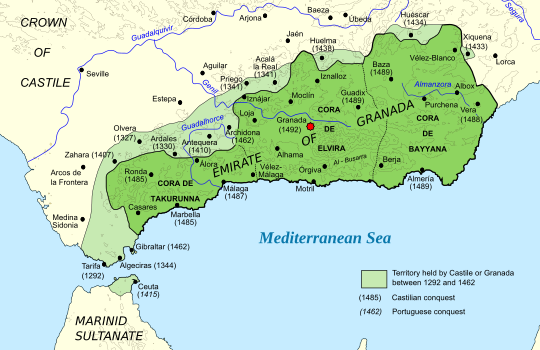Yusuf I of Granada facts for kids
Quick facts for kids Yusuf I |
|||||||||
|---|---|---|---|---|---|---|---|---|---|
| al-Muayyad billah | |||||||||
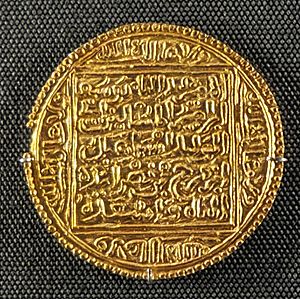
Dinar minted in Yusuf I's name
|
|||||||||
| Sultan of Granada | |||||||||
| Reign | 1333–1354 | ||||||||
| Predecessor | Muhammad IV of Granada | ||||||||
| Successor | Muhammad V of Granada | ||||||||
| Born | 29 June 1318 The Alhambra, Granada |
||||||||
| Died | 19 October 1354 (aged 36) The Alhambra, Granada |
||||||||
| Spouse | Buthayna, Maryam/Rim | ||||||||
| Issue Detail |
|
||||||||
|
|||||||||
| Arabic | أبو الحجاج يوسف بن إسماعيل | ||||||||
| Dynasty | Nasrid | ||||||||
| Father | Ismail I of Granada | ||||||||
| Mother | Bahar | ||||||||
| Religion | Islam | ||||||||
Yusuf I (born June 29, 1318 – died October 19, 1354) was a powerful ruler of the Emirate of Granada in what is now Spain. He was the seventh sultan from the Nasrid dynasty. His full name was Abu al-Hajjaj Yusuf ibn Ismail, and he was also known as al-Muayyad billah, which means "He who is aided by God".
Yusuf I became sultan in 1333 when he was just 15 years old, after his brother Muhammad IV was killed. At first, his ministers and grandmother helped him rule. He signed peace treaties with nearby kingdoms like Castile and the Marinid Sultanate. Later, he fought against Castile, but his army faced a big defeat at the Battle of Río Salado.
Despite military challenges, Yusuf I's time as sultan was a "golden era" for Granada. He supported art, science, and building projects. Many beautiful parts of the Alhambra palace were built or improved during his reign. He was killed in 1354 while praying.
Contents
Becoming Sultan: Yusuf's Early Life

Yusuf I was born on June 29, 1318, in the Alhambra palace in Granada. This palace was the home of the Nasrid dynasty. He was the third son of Sultan Ismail I. His mother was Bahar, a freed servant from Christian lands. People described her as kind and calm.
Yusuf's older brother, Muhammad IV, became sultan after their father was killed in 1325. Muhammad IV was also killed in 1333. This happened after he helped defend Gibraltar from an attack by Castile.
People described young Yusuf as strong and handsome. He had dark hair and large eyes. He loved elegant clothes, art, and building things. He also collected weapons and was good with machines. Before he became sultan, Yusuf lived in his mother's house.
Granada's Place in History
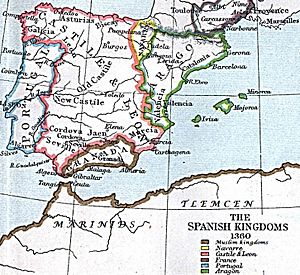
The Emirate of Granada was the last Muslim kingdom in Spain. It was founded in the 1230s. Granada managed to stay independent even though it was between two bigger powers. To the north was the Christian kingdom of Castile. Across the sea in Morocco was the Muslim Marinid Sultanate.
Granada would sometimes make alliances or go to war with these neighbors. This helped them avoid being taken over by either side. Sometimes, Granada's sultans paid money to the kings of Castile. This was a way for Castile to get income.
Before Yusuf, his brother Muhammad IV asked the Marinids for help against Castile. In return, he gave them some towns. The Marinids and Granada together captured Gibraltar. Muhammad IV was killed by his own commanders. These commanders were leaders of the "Volunteers of the Faith," North African soldiers who fought for Granada.
The Marinids had many soldiers and lands in Spain, especially around the Strait of Gibraltar. This allowed them to move troops easily. Castile's king, Alfonso XI, wanted to stop North African armies from coming into Spain.
Yusuf Becomes Sultan
When Yusuf became sultan, he was only 15 years old. At first, he had limited power. His grandmother, Fatima, and a high-ranking official named Ridwan helped him rule. They were like his teachers. Yusuf chose the name al-Mu'ayyad billah, meaning "He who is aided by God." This was a special title that most Nasrid sultans used after him.
Yusuf's Reign: Peace and War
Early Peace Treaties
After Muhammad IV died, the peace treaty he made was no longer valid. So, Yusuf's representatives met with leaders from Castile and the Marinids. They signed a new four-year peace treaty in February 1334. This treaty allowed free trade between the three kingdoms. It also said that Marinid ships could use Castilian ports. The Marinid Sultan promised not to send more soldiers to Spain. This was good for both Castile and Granada.
The King of Aragon also joined the treaty in May 1334. This brought a time of peace for Granada with all its neighbors. During this peaceful time, Yusuf took action against the family who had killed his brother. He removed their leader and sent the family away.
Fighting Castile and the Marinids
In 1339, the peace treaty ended, and fighting started again. Marinid soldiers raided Castilian lands. Castilian troops also attacked Granada. Yusuf led his army to fight back.
In April 1340, a big naval battle happened near Algeciras. The Marinid and Granadan fleets won a major victory against Castile. The Marinid Sultan, Abu al-Hasan, then brought his army, including siege machines, across the Strait of Gibraltar. Yusuf joined him, and they attacked the Castilian port of Tarifa.
King Alfonso XI of Castile and King Afonso IV of Portugal came to help Tarifa. They had a large army. The Muslim forces were also very big.
The Battle of Río Salado
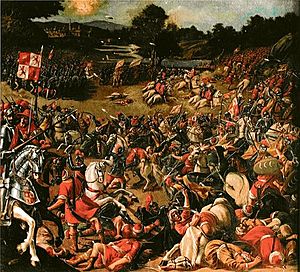
The Battle of Río Salado took place on October 30, 1340. It was a huge victory for the Christian armies. Yusuf, wearing a golden helmet, had to flee the battle. The Granadan soldiers fought bravely but were eventually defeated. The Marinid army also lost.
After the battle, Christian soldiers took many valuable things from the Muslim camp. They also captured many important people. Yusuf returned to Granada. The Marinid Sultan went back to North Africa. This defeat was a major setback for the Muslim cause.
After the Big Battle
With the Marinid army gone, Alfonso XI of Castile was free to attack Granada. In 1341, he invaded. He tricked Yusuf into sending soldiers to Málaga, then attacked another fortress, Alcalá de Benzaide. Yusuf tried to stop further raids into Granada's rich plains.
The Castilian army captured Alcalá de Benzaide in August 1341. They also took other towns like Locubín and Priego. In 1342, a Marinid-Granadan fleet was defeated by Castilian and Genoese ships.
The Siege of Algeciras
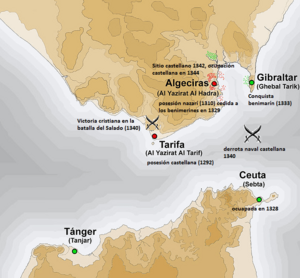
Alfonso XI then decided to attack Algeciras, an important port. He started a land and sea blockade in August 1342. Yusuf's army tried to distract the attackers by raiding Castilian lands.
The Muslim defenders of Algeciras used cannons. This was one of the earliest times cannons were used in a big battle in Europe. Soldiers from all over Europe came to help Alfonso.
In 1344, Alfonso built a barrier to stop supplies from reaching Algeciras. With the city starving, Yusuf started talking about peace again. He offered to surrender Algeciras if its people could leave safely. He also asked for a ten-year peace treaty between Granada, Castile, and the Marinids. Alfonso agreed. The treaty was signed on March 25, 1344.
The Siege of Gibraltar and Alfonso's Death
War started again in 1349. Alfonso XI attacked Gibraltar, a port that had changed hands several times. Yusuf sent soldiers to help defend the town. He also led his own attacks into Castilian territory.
During the siege, the Black Death (a terrible plague) spread through the Castilian camp. Alfonso XI himself got sick and died in March 1350. The Castilian army then left Gibraltar. Out of respect, Yusuf ordered his army not to attack the Castilian soldiers as they carried their king's body away.
Yusuf signed a new treaty with Alfonso's son, Peter I. Yusuf even sent his soldiers to help Peter put down a rebellion in Castile. This showed that Yusuf followed his treaty agreements.
Building and Culture Under Yusuf I
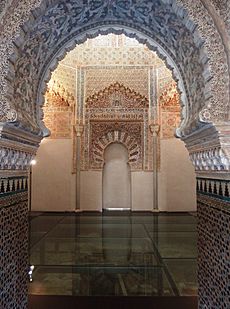
Yusuf I was a great builder. He added many beautiful structures to the Alhambra palace.
- He built the Tower of Justice in 1348, which was a grand entrance to the Alhambra.
- He also built the Broken Tower and worked on the Comares Palace. This included improving its bathhouse and building the Hall of the Comares, a very large room.
- He added new walls and towers to the Alhambra. His name can still be seen in the carvings on the walls.
- He built a small prayer hall at the Partal Palace and the Gate of the Seven Floors.
- He turned two towers into small palaces, like the Tower of the Captive.
In 1349, Yusuf founded a religious school called the Madrasa Yusufiyya. It was near the Great Mosque of Granada and offered higher education. Today, only its prayer room remains. He also built a guesthouse for merchants, the Corral del Carbón, which is the only one left from that time. Outside Granada, he improved the Alcazaba of Málaga and its fortress.
Yusuf also built many new defenses across his kingdom, especially after the defeat at Río Salado. He made existing castles and walls stronger. His official, Ridwan, built 40 watchtowers along the southern coast. Yusuf also reinforced the city walls of Granada.
How Yusuf I Ruled
Yusuf had many skilled ministers who helped him govern. One important person was Ridwan, who was the hajib (chamberlain). This was a very high position, even above other ministers. The hajib commanded the army when the sultan was not there.
After a big defeat, Ridwan was removed from his post for a while. Later, the famous poet Ibn al-Jayyab became Yusuf's vizier (a top minister). He was known for his careful policies. He also served as the royal secretary.
When the Black Death spread in 1348, it killed many scholars and officials, including Ibn al-Jayyab. His student, Ibn al-Khatib, took his place. Ibn al-Khatib was a brilliant writer and thinker. He wrote about history, poetry, medicine, and more. He had access to official documents, so his writings are a main source of information about Granada.
Yusuf I met with his people twice a week to hear their concerns. He listened to them with his ministers and family members. People loved Yusuf. He made a special visit to his eastern regions to check on the forts there. He was welcomed warmly by the people. Gold coins made during his reign were known for their beautiful designs.
Yusuf also sent a special message to the Mamluk Sultan in Cairo. He asked for military help against the Christians. The Mamluk Sultan wished him well but could not send troops.
Yusuf also focused on the law. He appointed good judges. He also strengthened the role of muftis, who were legal experts. The Madrasa Yusufiyya helped train more legal scholars. Yusuf's focus on fair laws made him popular.
Yusuf's Family Life
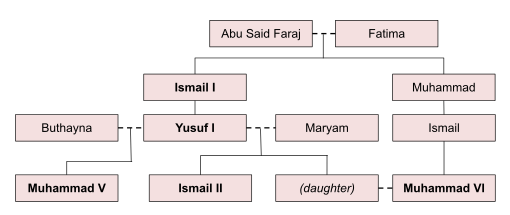
Yusuf I had two main partners, Buthayna and Maryam (or Rim). Both were originally from Christian lands. Buthayna gave birth to his first son, Muhammad (who later became Muhammad V), in 1339. She also had a daughter named Aisha.
Maryam/Rim had seven children with Yusuf: two sons, Ismail (who became Ismail II) and Qays, and five daughters. Yusuf seemed to favor his second son, Ismail. However, just before he died, Yusuf chose Muhammad to be his heir because he thought Muhammad had better judgment. Both Muhammad and Ismail were about 15 years old when their father died.
Yusuf's grandmother, Fatima, who was very important in the court, died in 1349 at 90 years old. Yusuf's mother, Bahar, was also active. When a famous traveler visited Granada, Bahar made sure he had enough money for his stay.
After Yusuf's death, his partner Maryam/Rim played a role in politics. In 1359, she helped her son Ismail take the throne from his half-brother Muhammad V.
Yusuf I's Death and Legacy
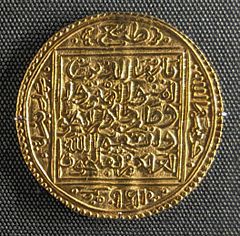
Yusuf I was killed on October 19, 1354, while praying in the Great Mosque of Granada. A man attacked him during the prayer. Yusuf was taken to his palace in the Alhambra, where he died. The attacker was quickly killed by a crowd. People believed the attacker was a madman and had no clear reason for his actions.
Yusuf was buried in the royal cemetery at the Alhambra. His son, Muhammad V, became the next sultan. Historians believe that Yusuf I's reign, along with his son Muhammad V's, was the "golden era" of the Nasrid dynasty. This was a time when Granada produced amazing architecture and culture. The study of medicine also grew.
Even though Yusuf faced military defeats, like at Río Salado and the loss of Algeciras, he managed to keep Granada strong. He also made Granada less dependent on the Marinids. His cultural achievements were very important and marked the start of a "Golden Age" for the dynasty.
See also
 In Spanish: Yusuf I de Granada para niños
In Spanish: Yusuf I de Granada para niños


